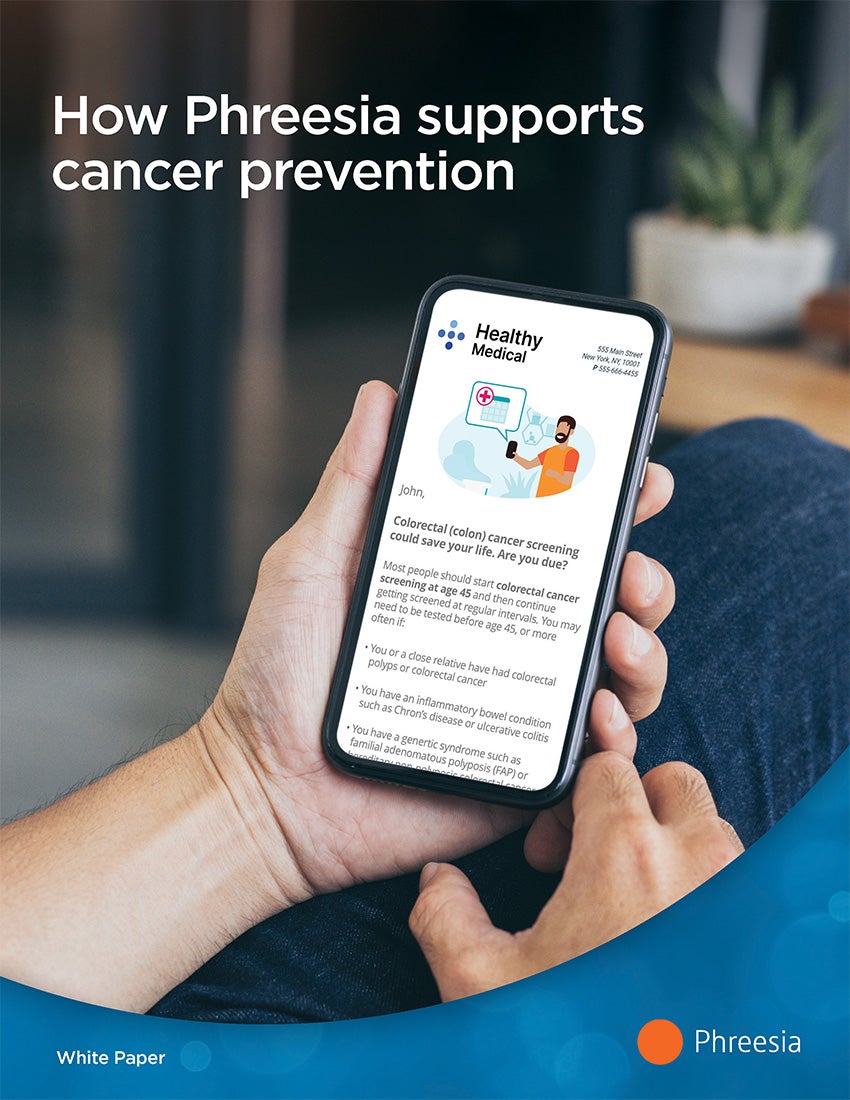Preventive screenings are key for detecting, diagnosing and preventing the progression of most cancers. But nationwide cancer screening prevalence dropped considerably during the COVID-19 pandemic—a trend that could inhibit providers’ ability to detect cancer early and save lives.
So, how can healthcare organizations restore cancer prevention efforts to pre-pandemic levels? The answer is simple: Use technology to encourage a return to routine screenings.
Phreesia directs patients toward a wide range of preventive cancer screenings—as well as diagnostic and treatment options—at a critical moment in their healthcare journey. This white paper explores the material impact of Phreesia’s cancer prevention efforts, including results for campaigns that address:
- Breast cancer screening
- Colorectal cancer screening
- Cervical cancer screening
- Lung cancer prevention
Click the image to download the white paper.
How Phreesia supports cancer prevention
Executive summary
Preventive healthcare—such as regular check-ups, vaccinations and screenings—can substantially reduce one’s risk of disease, disability and death. But many Americans face barriers to getting recommended preventive services, including cost, not having a regular doctor or not knowing about the preventive services they need.1 When it comes to cancer, preventive screenings are key: If cancer is diagnosed early, it is easier to treat, people are more likely to survive and their quality of life can improve.2
Ideally, every American would have a primary care provider (PCP) who ensures that they receive the cancer screenings and other preventive care they need. But PCPs would need almost 27 hours a day to provide comprehensive care, according to one study—and more than half of that time would be spent on preventive care.3 That approach is infeasible, but one way around it is a solution many healthcare organizations are already familiar with: Using technology to improve care.
Why cancer prevention matters
There is perhaps no other disease for which prevention is more important than cancer. The statistics bear emphasizing: Cancer is the second-most common cause of death in the U.S., killing about 1,670 people every day.4 Breast, lung and bronchus, prostate and colorectal cancers account for roughly half of all new cancer cases.5 But, if caught early, these cancers can be treated before they spread.
For patients, the benefits of prevention and early detection are numerous. Cancer screenings are critical for early diagnosis and treatment. Early detection enables patients to live longer, healthier lives and can reduce the need for intensive, expensive treatment. Millions of Americans skipped routine screenings during the pandemic, but campaigns that encourage a return to screenings can help restore nationwide cancer prevention efforts to pre-pandemic levels.6
Providers benefit from such campaigns, too, because their patients learn about screening options before they arrive for their appointments. And when patients are primed to have an informed, meaningful conversation during their visit, it’s easier for providers to discuss the benefits of adopting healthy behaviors, such as getting timely cancer screenings. Furthermore, some preventive screenings (including mammograms and colorectal cancer screenings) are included in the quality measures on which many providers or their organizations are required to report.
How Phreesia can help
As a healthcare technology company, Phreesia can leverage its intake platform to drive patients toward a wide range of preventive cancer screenings, as well as diagnostic and treatment options. Phreesia connects with patients at a critical moment in their healthcare journey—when they are checking in for a medical appointment. By engaging patients when they’re already thinking about their health, Phreesia can present them with tailored initiatives and campaigns that encourage them to get the preventive care they need. This is a simple and efficient way to mitigate the burden on providers and improve cancer screening rates.
Phreesia enabled more than 120 million patient visits in 2022—more than 1 in 10 visits across the U.S.—a scale that places Phreesia in a unique position to make meaningful, direct contact with patients.
A large body of evidence shows that presenting information in optimal ways can encourage people to make better decisions when faced with complex choices7—or in this case, encourage patients to pursue preventive care measures. Phreesia delivers messages that are timed strategically—such as when patients are getting ready for a medical visit—with easy-to-understand explanations of why screenings are necessary. Patients can immediately act on that information by considering questions they may want to ask their provider, requesting doctor discussion guides so that they have relevant information and example questions available during their appointment, and raising the topic when they enter the exam room. Phreesia’s campaigns also prompt patients to take action on important cancer screenings by presenting them with educational content when they may not have an upcoming appointment scheduled. Phreesia can deliver content to patients outside of a planned visit and give them the opportunity to request or self-schedule an appointment for the screenings they need. Many patients may learn for the first time that they should get screened for breast or colorectal cancer through such content, for example.
Effective patient-provider conversations are vital to patient activation—a measure of a person’s knowledge, skills and confidence in managing their health. Research has shown that as patients become more activated, they undertake new, healthy behaviors and make better choices, which reduces healthcare costs and ultimately improves outcomes.
In addition to reaching patients at key moments in their care journey, such as immediately before an annual wellness visit, Phreesia also runs messaging campaigns during awareness months—such as Colorectal Cancer Awareness Month in March or Breast Cancer Awareness Month in October—that give healthcare organizations a natural opportunity to encourage preventive screenings for relevant patient populations.
The impact of Phreesia’s cancer prevention efforts
Phreesia encourages patients to close gaps in their cancer screenings by presenting them with strategically timed content between appointments and/or during intake. Phreesia also prompts patients to self-report their family history so providers can better understand their hereditary cancer risk. Patients who see Phreesia’s content are more likely to schedule preventive screenings and discuss their importance with their provider.
Phreesia offers the following cancer prevention and early-detection campaigns during intake or between visits:
- Breast cancer screening
- Colorectal cancer screening
- Cervical cancer screening
- Lung cancer prevention
- Preventive cancer vaccine
- Sun safety
- Medicare Annual Wellness Visits, which include cancer screening for people over age 65
- Well-woman visits, which include screenings for women’s cancers
Here are some of the results Phreesia-delivered campaigns have produced to date:
Breast cancer screening
With millions of new diagnoses every year, breast cancer is the most prevalent type of cancer in the world.8 Yet according to the Centers for Disease Control and Prevention, more than 1 in 3 patients age 40 and over have not had a mammogram in the past two years.9
Campaign #1
In just 10 days, Phreesia reached 268,000 patients with one breast cancer awareness campaign.
- More than 80% of patients found the information they saw about breast cancer risks and screenings helpful
- Nearly all Black patients (94%) and the majority of non-white patients (89%) said the content was helpful, compared with 79% of white patients, indicating the campaign’s benefit in helping to close racial disparities in awareness on a key topic
- 72% of patients said they were likely to talk to their doctor about breast cancer risk factors after seeing the campaign. This is even higher among younger patients (35-44), with 83% saying they are likely to talk to their doctor
Campaign #2
- Between visits, one health system used Phreesia to notify more than 2,000 patients that they were overdue for a mammogram screening, and 10% of them self-scheduled a mammogram.
Campaign #3
- During intake, one health system asked more than 87,000 patients about their mammogram screenings, and 32% of them requested a mammogram appointment.
Colorectal cancer screening
Among adults ages 45 to 75 who are eligible for colorectal cancer screenings, 1 in 3 have not been screened. People of color are disproportionately impacted by colorectal cancer: If their screening rate was the same as that for white people, 20% of deaths from colorectal cancer could be prevented.
Impact
Phreesia ran a campaign to educate and engage patients soon-to-be due and overdue for colorectal cancer screenings. Patients received information about the importance of early detection and different screening options so that they could share their preferred screening modality with their care team.
- Among patients who viewed the campaign, nearly 10% completed all requested information regarding their risk factors and submitted their preferred screening modality to their provider
- 70% of patients who answered all questions regarding their risk factors and preferred screening modality did so on the same day they received the campaign
- Black/African American patient groups engaged with the campaign at a noticeably higher rate than other racial groups, suggesting an opportunity for providers to use such campaigns to help close the racial gap in colorectal cancer screening
- 40% of patients identified risk factors that placed them in the “high risk” category for colorectal cancer, indicating a need for timely screening
Cervical cancer screening
Nationwide, 23% of women were overdue for cervical cancer screening as of 2019—up from just 14% in 200510—even though routine screening is a proven way to prevent cervical cancer.11
Impact
- One health system asked more than 4,800 women about their cervical cancer screenings during intake, and 30% said they would discuss cervical cancer screening options with their provider.
Lung cancer prevention
Lung cancer causes more than 350 deaths each day, the highest number of deaths for all types of cancer. Rates of e-cigarette use or vaping have dramatically increased in recent years, particularly among young people, 7.7% of whom (more than 2.1 million) currently use e-cigarettes.
Impact
- In a lung cancer screening campaign, patients 50-80 years old with a history of smoking were 234% more likely to get screened for lung cancer after seeing the campaign.
- In an anti-vaping campaign targeted at youth, caregivers checking in patients age 10-14 who saw the campaign were more likely to understand the facts about vaping, believe their child may be at risk and talk to their child’s doctor about the risks of vaping. The campaign was delivered over 165,000 times to caregivers, and over 4,200 requested more information.
Family history of cancers
Phreesia collects information about past medical history and family history during intake and can collect individual and family histories for cancers known to have a strong link to genetic defects or mutations inherited from a family member. Collecting this information can help providers learn whether a patient is at risk for a hereditary cancer and reminds both the provider and the patient to remain vigilant about getting regular screenings.
Through its personal and family history questions, Phreesia can gather information about a patient’s family cancer history for the following cancers, among others:
- Breast
- Colorectal
- Prostate
- Endometrial (uterine)
- Pancreatic
- Ovarian
- Lynch syndrome-associated
How Phreesia could amplify impact
Ending cancer as we know it is a priority for the Biden Administration, and expanding access to cancer screenings is a key pillar of the administration’s Cancer Moonshot initiative.12 Phreesia’s campaigns have a proven track record of increasing rates of preventive screening and vaccination. Our outreach messaging encourages more people to get screened, helping provider organizations detect cancer earlier and save lives.
But Phreesia has the potential to reach even more patients. That’s why we’re launching a holistic module that aims to improve cancer screening rates for breast, cervical, colorectal and lung cancer. The module includes digital outreach and scheduling, automated clinical intake questions and personalized post-check-in education. Through this effort, we hope to encourage healthcare organizations to adopt the full suite of cancer prevention tools Phreesia has to offer. By building upon the demonstrated success of our past preventive health campaigns—and by launching this comprehensive cancer-prevention initiative—Phreesia has the potential to move the needle on the national effort to eradicate cancer. Learn more about our commitment to prevention and early detection at phreesia.com/close-gaps-in-care.
About Phreesia
Phreesia is the trusted leader in patient activation, giving providers, health plans, life sciences companies and other organizations tools to help patients take a more active role in their care. Founded in 2005, Phreesia enabled more than 120 million patient visits in 2022—more than 1 in 10 visits across the U.S.—scale that we believe allows us to make meaningful impact. Offering patient-driven digital solutions for intake, outreach, education and more, Phreesia enhances the patient experience, drives efficiency and improves healthcare outcomes. To learn more, visit phreesia.com.
End notes
1. “Preventive Care – Healthy People 2030,” Office of Disease Prevention and Health Promotion, U.S. Department of Health and Human Services, Aug. 18, 2020.
2. Whitaker K. Earlier diagnosis: the importance of cancer symptoms. The Lancet Oncology. 2020;21(1):6-8. https://doi.org/10.1016/S1470-2045(19)30658-8
3. Porter J, Boyd C, Skandari MR, Laiteerapong N. Revisiting the Time Needed to Provide Adult Primary Care. J Gen Intern Med. 2023;38:147-155. https://doi.org/10.1007/s11606-022-07707-x
4. Siegel RL, Miller KD, Wagle NS, Jemal A. Cancer statistics, 2023. CA: A Cancer Journal for Clinicians. 2023;73(1):17-48. https://doi.org/10.3322/caac.21763
5. “Cancer Stat Facts: Common Cancer Sites,” National Cancer Institute, Surveillance, Epidemiology, and End Results Program, 2023.
6. Star J, Bandi P, Siegel RL, Han X, Minihan A, et al. Cancer Screening in the United States During the Second Year of the COVID-19 Pandemic. Journal of Clinical Oncology. 2023;41(27):4352-4359. https://doi.org/10.1200/jco.22.02170
7. Purnell JQ, Thompson T, Kreuter MW, McBride TD. Behavioral Economics: “Nudging” Underserved Populations to Be Screened for Cancer. Prev Chronic Dis. 2015;12:140346. http://dx.doi.org/10.5888/pcd12.140346
8. “Breast cancer,” World Health Organization, July 12, 2023.
9. “Mammography,” Centers for Disease Control and Prevention, National Center for Health Statistics, June 26, 2023.
10. “Why Are Many Women Overdue for Cervical Cancer Screening?” National Cancer Institute, Feb. 22, 2022.
11. “Can Cervical Cancer Be Prevented?” American Cancer Society, July 30, 2020.
12. “Cancer Moonshot,” The Cancer Cabinet, The White House, Sept. 13, 2023.






